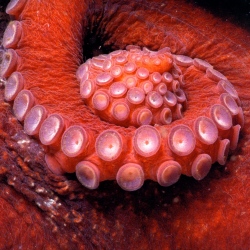
Octopuses’ oddities run deep—right down to their blue-hued blood. And new research shows how genetic alterations in this odd-colored blood have helped the octopus colonize the world’s wide oceans—from the deep, freezing Antarctic to the warm equatorial tropics.
The iron-based protein (hemoglobin) that carries oxygen in the blood for us red-blooded vertebrates becomes ineffective when faced with low-oxygen levels. This is one of the reasons why, for example, we tire more quickly from exercise at high altitudes.
To cope with the super-low oxygen levels in the deep ocean, the octopus instead uses a copper-based transporter protein called hemocyanin. This is much more efficient in keeping their bodies properly oxygenated. And the copper in hemocyanin makes their blood run blue. Cephalopods aren’t the only animals with hemocyanin. Horseshoe crabs, lobsters and a handful of other invertebrates also make use of this substance instead of hemoglobin.
Researchers at the Alfred Wegener Institute for Polar and Marine Research in Germany have found that not all blue blood is the same, however—even among octopuses. When they compared the hemocyanin of octopuses that live in -1.9 degree Celsius waters to those that live in seas closer to 30 degrees Celsius, they found some distinct differences. The research was presented earlier this month at the Society for Experimental Biology meeting in Valencia, Spain.
